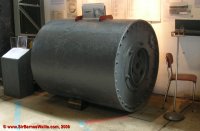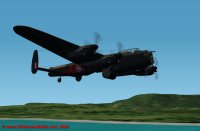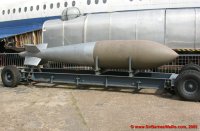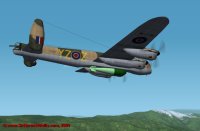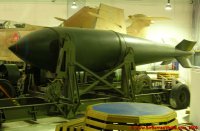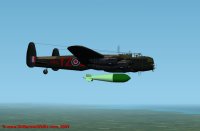Wallis’s Bombs - Big and Bouncy
On the day that World War II broke out, Barnes Wallis asked himself what he, as an engineer and aircraft designer, could do to shorten the war. Over the next six years, he worked on a variety of aircraft and weapons, and while the magnitude of his contribution is impossible to measure in isolation, shorten it he surely did. The goals he set himself were often regarded as far-fetched, yet his tenacity saw them through development, and the quality of his engineering was demonstrated again and again as his special weapons performed exactly as he predicted.
Even before World War II had begun, the Air Ministry and various individuals were investigating possible bombing targets within Germany. However, most targets were effectively protected by dispersal, that is that they covered a wide area and it was thus difficult to destroy them completely (and as late as 1941, less than 10% of bombs were falling within 5 miles of their targets, although numerous navigation aids and bombsights were introduced which improved matters considerably as the war progressed). Wallis focussed his thinking on destroying targets which could not be dispersed - "highly localised stores of energy in the form of coal, oil and water power", especially dams, and in particular the great dams of the Ruhr area (the Möhne, Sorpe, Eder and several others). These targets were particularly attractive for several reasons:
- they could not be moved, and their location was known
- great damage would be caused by the flow of water when the dam was broken
- massive flooding would be caused to mines, steelworks and other industries by the released water
- the loss of water would disrupt steel production and hydro-electric generation, as well as causing problems with supplies for canals and drinking
However, the dams were so massive that the armaments of the time (mostly 500lb bombs and (from 1940) 1000lb general-purpose bombs) would simply not touch them.
Wallis's main concept developed for these targets was the "big bomb", a ten-ton weapon to be carried by a six-engined "Victory bomber" - dropped from 40,000ft, the bomb would penetrate deep into the ground, and the shock wave caused by the huge explosion would act like an earthquake and simply shake the target to pieces (and a direct hit was not necessary). However, at the time of his proposal (finalised in a report in March 1941), the RAF had only just begun using 4-engined bombers (most of their bombers had only 2 engines), and the idea of carrying a ten-ton bomb up to 40,000ft seemed like pure fantasy, so his proposals for the bomber and the bomb were quickly rejected by the Air Ministry (despite Wallis' excellent credentials as an aircraft engineer).
Meanwhile, ongoing experiments on the amount of explosives needed to break a dam wall (mostly performed without Wallis's direct involvement) had found that while significant quantities (30,000lbs - 14 tons) were needed if the explosion was tens of feet away from the dam, as little as 6,500lbs (under 3 tons) would be sufficient if the explosion took place in contact with the wall. Several 1/50th models and a disused dam at Nant-y-Gro in Wales were destroyed in arriving at this conclusion.
Upkeep and Highball - the "bouncing bombs"
Early in 1942, Wallis had the idea of "a missile" which would be dropped upstream of a dam, ricochet over the water in a series of bounces, and hit the dam - this offered two significant advantages: it would jump over anti-torpedo nets placed ahead of the dam wall, and would sink right up against the dam (the perfect location, as revealed by the earlier tests). Some initial tests led him to develop a spherical bomb, and full-scale test drops of this design began at Chesil Beach in September 1942 using a modified Wellington bomber. Persuaded by Wallis and films of the test drops, officials gave the go-ahead for further tests which led to the development of two separate variants of the "bouncing bomb" idea - a large version (codenamed Upkeep) to be carried by the new Lancaster for use against dams (Wallis was confident that if one mine could be dropped in the right place, a dam could be breached) and a smaller one (codenamed Highball) to be carried by Mosquitoes for use against capital ships, such as the Tirpitz. A variety of shapes, drop heights and backspin rotation speeds were tested at Chesil Beach and Reculver in Kent (Highball was also tested at Loch Striven in Scotland) - Upkeep proved satisfactory, although Highball was initially found to be less accurate after release.
The Dams Raid - "Operation Chastise" - May 1943
By early 1943, the best time to hit the dams (when they were full after the Spring rains) was approaching, and on 26th February the go-ahead was given to prepare for raid on the Ruhr dams using Upkeep (Highball development continued in parallel). Twenty-three Lancasters were modified to carry the Upkeep mine (originally a sphere, it was modified to a cylindrical shape during testing), and 617 Squadron was formed to perform the mission. On 16th May 1943 (the night of a full moon), 19 Lancasters of the squadron under Wing Commander Guy Gibson took off from RAF Scampton (Lincolnshire) in three waves to attack the Möhne, Eder and Sorpe Dams.
Möhne Dam: After a dummy run over the dam to check out the approach and defences, Gibson (AJ-G) dropped the first Upkeep, but his mine detonated too far from the dam. Hopgood (AJ-M) then attacked, but was hit by flak during his approach, and the mine was dropped late - it bounced over the dam, and detonated on the power station below the dam; Hopgood's aircraft gained some height before exploding, but two of the crew did manage to escape, although they were seriously injured and became PoWs. Martin (AJ-P) then attacked, but his Upkeep veered to the left and exploded 20 yards from the dam. Young (AJ-A) then attacked, and after three bounces, his Upkeep mine exploded in contact with the wall. Maltby (AJ-J) then came in to attack, but as his Upkeep was dropped, it was realised that the dam was already crumbling. His mine also exploded in contact with the wall, and together with Young's, a breach 76m wide was created. Young was unfortunately shot down on his way home (the third time he had come down in the sea, but he did not survive this time).
Eder Dam: Gibson and Young flew on to the Eder with the three aircraft that still had their mines, while Martin and Maltby headed for home. After locating the dam, Shannon (AJ-L) made four passes over it, the steep dive and turn required to line up with the target proving difficult (the mine was not to be dropped unless the bomb aimer was completely happy with the approach). Maudslay (AJ-Z) tried twice, then Shannon twice more before releasing his mine, which exploded close to the dam towards one end. Maudslay attacked again, this time releasing his mine, but it hit the parapet of the dam and exploded; it seems probable that the explosion damaged the aircraft, as there was no further communication from Maudslay, and his aircraft was brought down near the Dutch border on its way home. Knight (AJ-N) made one dummy run, releasing his mine on the second; it bounced three times before hitting the dam, and punched a hole about 10m in diameter through the masonry, although the flow of water quickly widened the breach to around 70m.
Sorpe Dam: Unlike the Möhne and Eder Dams which were walled dams, the Sorpe was constructed with a concrete wall core flanked by earth banking on both sides. Different tactics were thus employed against the dam, which was to be attacked along its crest, and the mine dropped without spin. McCarthy (flying AJ-T as his own AJ-Q had developed a fault immediately before the mission) made the first attack, making nine dummy runs as the target was covered in mist; on the tenth run, the mine was dropped and exploded on the dam crest. Brown (AJ-F) also made several dummy runs, dropping his mine on the sixth run. It also exploded on target but, although the crest was damaged, the dam was not breached and no seepage through the core (as hoped for) resulted. The damage to the crown of the dam, however, required the Germans to half empty the reservoir to effect repairs, so there was some water loss as a result of the attack.
Other dams: Several other dams in the Ruhr area (Lister, Ennepe, Diemel, Henne) were reserve targets for the raid, to be attacked by remaining aircraft if the main targets were destroyed. Townsend (AJ-O) was diverted to attack the Ennepe; on the fourth run, the Upkeep was dropped, but it exploded short of the dam. It was subsequently established that it was the Bever Dam which had been attacked (the Bever reservoir was a similar shape to the Ennepe and only five miles away), but as the aiming sights were set for the Ennepe, a hit would have been impossible (also, the Bever dam was an earth-bank dam like the Sorpe, rather than a walled gravity dam), although there remains some uncertainty about which dam was actually attacked.
Other aircraft: Although only one Lancaster was shot down during the actual dam attacks, aircraft flown by Astell (AJ-B), Byers (AJ-K), Ottley (AJ-C), Burpee (AJ-S) and Barlow (AJ-E) were brought down en route (Barlow's Upkeep was retrieved intact by the Germans); one member of Ottley's crew survived the crash. In addition, Munro (AJ-W) turned back after suffering severe flak damage crossing the Dutch islands, and in the same area Rice (AJ-H) flew too low and his mine was torn off by the sea; he managed to regain height and return safely to Scampton with a somewhat shaken (and wet) crew! Finally, Anderson (AJ-Y) made it to the Ruhr, but was unable to locate any targets in the early morning mist, and returned home with his mine (Gibson was somewhat displeased with this).
Aftermath: The result of Operation Chastise, its impact on the war and its cost in terms of lost aircraft and men (out of 19 aircraft, 8 were lost and 53 of the 56 crew in those aircraft were killed) has been the subject of much controversy. Typical Bomber Command raids of the time were experiencing losses around 5% of aircraft despatched (often not hitting their targets!), and Operation Chastise was well above this; however, its losses were not directly attributable to Upkeep (only one aircraft was lost in the actual dams attacks), but more to the low-level approach and bad luck. The propaganda benefits to Britain, and the corresponding damage to morale in Germany, were not insignificant.
It is clear, however, that the raid was a great technical success, and achieved its principal aims. Two dams were destroyed (more than 116 million m3 of water was released from the Möhne reservoir, 154 million m3 from the Eder), causing widespread damage and destruction up to 100 miles away. 25 bridges were destroyed (plus 21 damaged), 11 factories were destroyed (plus 14 damaged), and many coal mines, waterworks, pumping stations and power stations were destroyed or put out of action (many were operational again within weeks or months, and the dams were both rebuilt during 1943, though this in turn caused a large diversion of manpower). Casualties on the ground were around 1300, more than half of whom were foreign labourers, many housed in barracks a few miles below the Möhne Dam; there were also losses of livestock and agricultural land.
Although it was highly successful in Operation Chastise, Upkeep was never used again in warfare. There were plans to use it against other dams, and experiments were also conducted dropping Upkeep (unspun) on land, principally for use against canals and bridges, but these experiments came to nothing.
However, Wallis’s original concept was vindicated - Upkeep had been able to destroy the huge dams, and (although five mines were dropped against the Möhne, and three against the Eder) it was the first mine to be dropped in the right place that had broken the dam in each case.
The Upkeep retrieved by the Germans from the Operation Chastise crash allowed them to quickly develop a specification for the weapon, and from this they developed their own spherical bouncing bomb, codenamed Kurt (although in fact it was more similar to Highball). It used a rocket motor for additional speed after dropping, but it suffered the same teething problems as Highball and these had not been rectified by the end of the war.
Operation Chastise is the subject of The Dam Busters movie (1955); a remake by Peter Jackson (Lord of the Rings etc.) has been in pre-production for over 10 years but remains forthcoming.
I created this Dambusters Lancaster model
which demonstrates the correct positioning of the spotlight altimeters and uses the beams to form the stand.
The other “bouncing bomb” - Highball
Although in development alongside Upkeep, the smaller spherical Highball exhibited some teething troubles which had not been resolved by the time of the dams raid. Development work and training for an attack on Tirpitz continued throughout the summer of 1943 - 618 Squadron had been formed specially to use the weapon. However, by the autumn it was reckoned that the X-craft midget submarines had a better chance of destroying the battleship, and 618 was stood down (part of the squadron went to Cornwall to perform anti-U-boat duties using Mosquitoes fitted with a 6-pdr gun).
By the early summer of 1944, it was reckoned that all the technical problems with Highball had been overcome, and it was decided to use it in the Pacific against Japanese ships. 618 Squadron received some new recruits who spent the summer months training to use the weapon, and doing carrier landing practice (the Highball Mosquitoes would have been launched from a fleet carrier). In October, the Squadron, weapons and ground crews embarked on two small escort carriers to travel to Australia, arriving at Christmas. Based at Narromine in New South Wales, the squadron performed some navigation exercises, but were never called to action. 618 was disbanded in July, even before the war against the Japanese was over, and the squadron’s equipment was either destroyed (including the Highballs) or shipped back to the UK.
Highball was considered as a weapon for attacking tunnels, and trials were conducted in October 1943 as part of the "Grouse Shooting" project. Highballs were dropped into the mouth of a disused railway tunnel at Maenclochog in Wales, most successfully entering the tunnel mouth (and some even going right through, as the tunnel was quite short). However, static explosives tests showed that the weight of explosive required to collapse a tunnel was too large, and the idea was not pursued.
The Americans also tested Highball under the codename Speedee using a Douglas A-26 Invader, but during one of their early tests, the bomb rebounded and hit the dropping aircraft causing it to crash (despite the many wartime Highball tests conducted in the UK, no Mosquitoes were damaged during any of these tests - although one crashed during rough-water trials after the war).
Development work continued on Highball for several more years (a new magnesium alloy version was even developed), but interest in longer-range guided weapons left it as one of the most-tested air-dropped secret weapons never to see active use.
Many test and training drops were carried out at Loch Striven in Scotland, and two Highballs were recovered from the loch by divers in July 2017 and are now on display at Brooklands Museum and the de Havilland Museum.
The Big Bombs - Tallboy
After the dams raid, Air Chief Marshall Arthur "Bomber" Harris was delighted (originally he had been against development of the weapon), and told Wallis "Now you could sell me a pink elephant" ... so Wallis turned his attention back to the big bombs.
Harris decided to retain 617 Squadron as a special operations squadron. They were becoming experts in accurate bombing from great height, but paradoxically found the problem was difficulty in marking targets effectively at low level. This was eventually solved by dive bombing markers into place using Lancasters and later Mosquitoes and eventually Mustangs. They had been using large blast bombs, but these were found to be only effective through direct hits. The Antheor Viaduct in southern France was attacked in 3 separate raids, the last placing 12,000 pounders within 5 yards ... yet the viaduct was not seriously damaged. The Dortmund-Ems canal was also attacked unsuccessfully using 12,000lb blast bombs. The need for Wallis' earthquake bomb was confirmed!
During 1943, Wallis continued developing plans for his 10-ton (22,000lb) bomb, and an order was placed for them and a smaller 6-ton (12,000lb) version in August for expected delivery in January 1944 (named Tallboy Large and Tallboy Medium respectively). However, following the attack on the V-weapon complex at Peenemünde on 17th August 1943, the Air Ministry decided that the 10-tonner was no longer needed, but work was to concentrate on Tallboy Medium (later known simply as Tallboy).
Tallboy's sleek shape enabled it to gain as much speed as possible during its fall, giving maximum penetration into the ground which was essential to maximise the earthquake effect. This speed also gave rise to a couple of problems with the design. Firstly, the ground impact at high speed meant that the casing had to be very strong to prevent it bursting open, and several metals were tested for this purpose; the weight of the case was thus a high proportion of the weight of the bomb so, despite its size, it was classed as a "medium capacity" weapon! Secondly, during trials, it was found to be inaccurate, and this was attributed to the bomb "toppling" off course as it passed through the sound barrier. Wallis solved this problem rather neatly by offsetting the bomb's tailfins by 5°; this made the bomb spin as it fell, and the gyroscopic effect prevented the toppling and thus maintained the accuracy.
Lack of ground penetration was a potential problem, as the bomb was originally intended to be dropped from 40,000ft, but the specially modified Lancasters could only carry it up to a maximum of 25,000ft; however, in practice this was found not to be a serious problem.
Tallboy was 21' in length, with a diameter of 3'8" overall (the bomb casing itself was 10'4" long and 3'2" in diameter). It weighed a total of 11,855lbs, of which 5,200 was Torpex D1 explosive. The size of the bomb required special “bulged” bomb bay doors to be fitted to the Lancasters.
The first Tallboys were dropped on 8th June 1944 on the Saumur railway tunnel in the Loire Valley; the tunnel roof was caved in, blocking this resupply route to the German front line against the invasion. Invasion forces were being harassed by night attacks from E-boats out of Le Havre, so the second Tallboy raid on 14th June was mounted on the Le Havre docks as the E-boats were gathering to depart. A similar attack was mounted at Boulogne the next day, and between these two raids, over 100 vessels were destroyed, some flung up onto the quayside. On June 16th, V1 "flying bombs" began falling on London, and bombing efforts switched to the launch sites of these weapons.
Over the next six months, over 700 Tallboys were dropped (mostly by 617 Squadron, joined in October by 9 Squadron). It was used against a variety of targets including:
- V-weapon sites - V1 and V2 launch sites and the V3 (giant gun) blockhouses: the latter were never used due to the damage caused
- concrete pens for U-boats, E-boats and R-boats
- the battleship Tirpitz (which attracted 76 Tallboys during three separate attacks, the first of which damaged her (though this was not appreciated at the time) and the last of which sank her) and the heavy cruiser Lützow (which was also sunk)
Most interestingly, the bomb was used against dams (one of the principal targets for the big bombs from their inception, of course). The Kembs Barrage in Alsace (part of the Rhine canal system) was successfully breached on 7th October 1944, thus preventing the Germans using it to flood U.S. troops approaching from Belfort. Uniquely on this raid, the Tallboys were dropped at low level for accurate positioning; use of Upkeep again would have been more appropriate, but most of the Lancasters had been converted back to standard configuration and there was not enough time to train the new crews for delivery of the weapon. The Sorpe Dam was also attacked with Tallboys (by 9 Squadron conventionally from 14,000ft) on 15th October 1944 and hit by two Tallboys (plus several near misses) but not breached (one Tallboy was found in the mud when the dam was partially drained in 1958, and successfully defuzed). Three raids were also mounted against the Urft Dam, 30 miles SW of Cologne, during December, again to prevent it being used to flood troops, and the lip of the dam was damaged, but the Germans prevented further damage by lowering the water level.
Tallboy was thus highly successful, and Wallis's original idea (using a large underground explosion to create an earthquake effect) was again vindicated in practice. Its successful use against the U-boat pens and V-weapon blockhouses was significant - curiously, these targets did not exist when Wallis conceived his big bombs, and yet they were the only type of weapon that would have been effective against them.
The Big Bombs - Grand Slam
The successful use of Tallboy led to the Ministry of Aircraft Production finally giving the go-ahead in July 1944 for the production of the larger (22,000lb) variant, now codenamed Grand Slam, for delivery in early 1945 - this was the ten-ton deep penetration bomb conceived by Wallis five years earlier. Its greater size required further development of techniques for making the casing, and meant that few places could machine the casing (it took two days for the initial casting to cool sufficiently for machining)! Although on paper well above the maximum load for a Lancaster, the modifications made to the B.1 Specials included the removal of gun turrets allowing the aircraft to carry Grand Slam up to an acceptable drop height (its greater size meant also that the Lancasters' bomb bay doors had to be removed entirely).
Its first use was against the Bielefeld Viaduct - 3,000 tons of bombs (including Tallboys) had already been dropped on it with little result, but Grand Slam brought it down on 14th March 1945 (the first Grand Slam had been test dropped in the New Forest the day before). Grand Slam was used against similar targets to Tallboy (often a raid would include both types of bomb), and again caused remarkable destruction wherever it was used - the Arnsberg, Arbergen, Neinburg and other bridges were also to be felled by the bomb. In total, 41 Grand Slams were dropped during the war.
The Americans were also producing Tallboys and Grand Slams by early 1945 (originally 400 were ordered from the UK and 200 from the US). There were plans to send 617 Squadron to the Pacific to use Tallboy and Grand Slam against targets in Japan, but in August 1945, bombs of far greater power brought the war to a close (these were dropped with an average error of 300 yards, which was laughable compared to the accuracy achieved by 617 Squadron by that time, although this was of little consequence)! After the war, bomb penetration tests with Tallboy and Grand Slam were conducted. Tallboys and Grand Slams were also carried experimentally by American B-29s (Operation Ruby) either recessed in the bomb bay with doors removed, or slung under the wings. The Americans also used the British-designed 4,500 lb rocket assisted Disney bomb to achieve greater penetration by force rather than by weight alone, although they did also develop their own 44,000lb version of the earthquake bomb, the T12 - this was tested using a B-29, but it could barely get off the ground with it (even with a light fuel load).
Can you help with more information?








